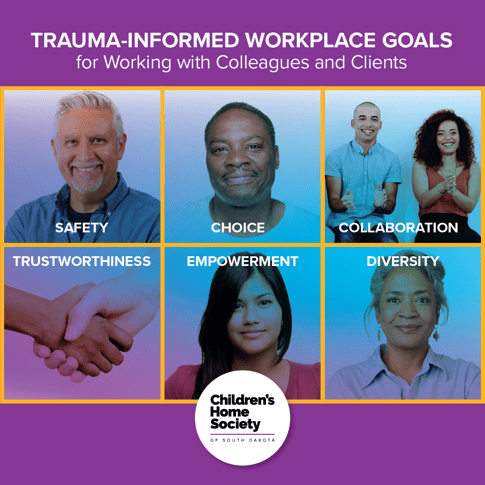A trauma-informed perspective asks, “What happened to you?” instead of “What’s wrong with you?”
Trauma-Informed Language
Trauma
An event or series of events, an experience or prolonged experiences, and/or a threat or perceived threats to a person’s well-being. The individual’s daily coping mechanisms can be negatively impacted by trauma. Subsequent behavioral responses to daily life may be filtered through this perspective.
Trauma-informed care
A framework of thinking and interventions that are directed by a thorough understanding of the profound neurological, biological, psychological and social effects trauma has on an individual—recognizing that person’s constant interdependent needs for safety, connections, and ways to manage emotions/impulses.
Triggers
Signals that act as signs of possible danger, based on historical traumatic experiences and which lead to a set of emotional, physiological, and behavioral responses that arise in the service of survival and safety (e.g., sights, sounds, smells, touch). Triggers are all about one’s perceptions experienced as reality. The mind/body connection sets in motion a fight, flight or freeze response. A triggered individual experiences fear, panic, upset and agitation.
“Trauma can serve as a filter, or lens, through which a person views the world. Think of sunglasses: You put them on and everything is shaded differently. Trauma can have that type of effect on how a person perceives their world.”
Trauma Types
There are three main classifications of trauma.
Acute trauma (Type I) results from exposure to a single overwhelming event. Examples: Rape, death of a loved one, natural disaster. Characteristics: Detailed memories, omens, hyper-vigilance, exaggerated startle response, misperceptions or overreactions.
Complex trauma (Type II) results from extended exposure to traumatizing situations. Examples: Prolonged exposure to violence or bullying, profound neglect, series of home removals. Characteristics: Denial and psychological numbing, dissociation, rage, social withdrawal, sense of foreshortened future.
Crossover trauma (Type III) results from a single traumatic event that is devastating enough to have long-lasting effects. Examples: Mass casualty school shooting, car accident with fatalities involved, refugee dislocation. Characteristics: Perpetual mourning or depression, chronic pain, concentration problems, sleep disturbances, irritability.
This short video clip explains empathy, which is the foundation of a trauma-informed approach: Brené Brown on Empathy.
CHS Trauma-Informed Workplace Goals for Working with Colleagues and Clients

- Safety: Ensuring physical and emotional safety
Principles in Practice: Common areas are welcoming and privacy is respected. - Choice: Individual has choice and control
Principles in Practice: Individuals are provided a clear and appropriate message about their rights and responsibilities. - Collaboration: Making decisions with the individual and sharing power
Principles in Practice: Individuals are provided a significant role in planning and evaluating services. - Trustworthiness: Task clarity, consistency and interpersonal boundaries
Principles in Practice: Respectful and professional boundaries are maintained. - Empowerment: Prioritizing empowerment and skill building
Principles in Practice: Providing an atmosphere that allows individuals to feel validated and affirmed with each and every contact at CHS. - Diversity: Understanding cultural, historical and gender inclusivity
Principles in Practice: Providing acceptance, non-judgmental and respectful perspective of race, ethnicity, age, gender, sexual orientation and history.


